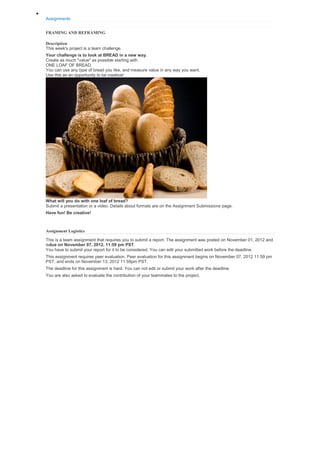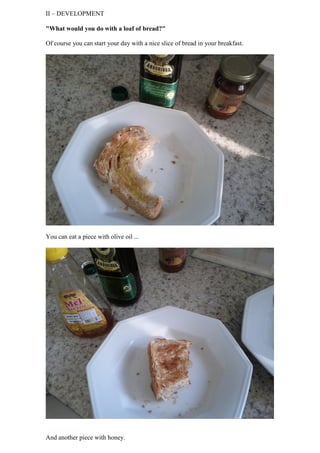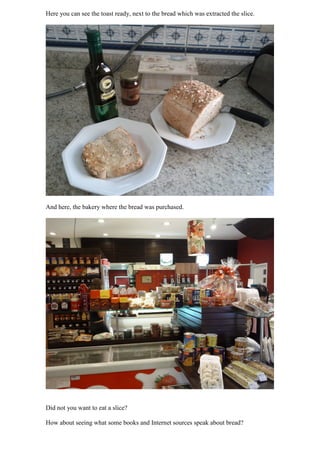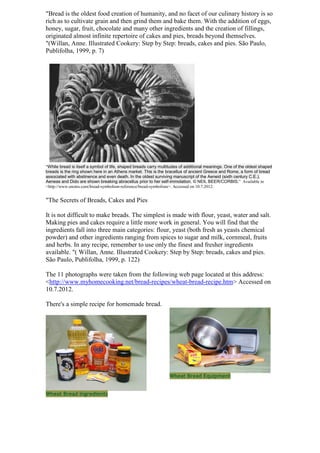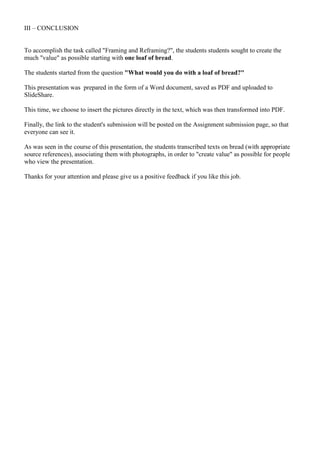Paulo pedrozo and luciana ellers framing and reframing
- 1. • Assignments FRAMING AND REFRAMING Description This week's project is a team challenge. Your challenge is to look at BREAD in a new way. Create as much "value" as possible starting with ONE LOAF OF BREAD. You can use any type of bread you like, and measure value in any way you want. Use this as an opportunity to be creative! What will you do with one loaf of bread? Submit a presentation or a video. Details about formats are on the Assignment Submissions page. Have fun! Be creative! Assignment Logistics This is a team assignment that requires you to submit a report. The assignment was posted on November 01, 2012 and isdue on November 07, 2012, 11:59 pm PST. You have to submit your report for it to be considered. You can edit your submitted work before the deadline. This assignment requires peer evaluation. Peer evaluation for this assignment begins on November 07, 2012 11:59 pm PST, and ends on November 13, 2012 11:59pm PST. The deadline for this assignment is hard. You can not edit or submit your work after the deadline. You are also asked to evaluate the contribution of your teammates to the project.
- 2. Resolution: A Crash Course on Creativity Professor Tina Seelig, Stanford University Students: Paulo Pedrozo and Luciana Eller Team: 26038 I - INTRODUCTION To accomplish the task called "Framing and Reframing?", the students students will seek to create the much "value" as possible starting with one loaf of bread. The students will start from the question "What would you do with a loaf of bread?" This presentation will be prepared in the form of a Word document, saved as PDF and uploaded to şÝşÝߣShare. This time, we chose to insert the pictures directly in the text, which was then transformed into PDF. Finally, the link to the student's submission will be posted on the Assignment submission page, so that everyone can see it. As will be seen in the course of this presentation, the students will transcribe texts on bread (with appropriate source references), associating them with photographs, in order to "create value" as possible for people who view the presentation.
- 3. II – DEVELOPMENT "What would you do with a loaf of bread?" Of course you can start your day with a nice slice of bread in your breakfast. You can eat a piece with olive oil ... And another piece with honey.
- 4. You can eat the bread toasted or not. If you want to roast it, need a toaster.
- 5. If the bread is not already sliced, you'll need a proper knife to slice it.
- 6. Here you can see the toast ready, next to the bread which was extracted the slice. And here, the bakery where the bread was purchased. Did not you want to eat a slice? How about seeing what some books and Internet sources speak about bread?
- 7. "Bread is the oldest food creation of humanity, and no facet of our culinary history is so rich as to cultivate grain and then grind them and bake them. With the addition of eggs, honey, sugar, fruit, chocolate and many other ingredients and the creation of fillings, originated almost infinite repertoire of cakes and pies, breads beyond themselves. "(Willan, Anne. Illustrated Cookery: Step by Step: breads, cakes and pies. São Paulo, Publifolha, 1999, p. 7) “While bread is itself a symbol of life, shaped breads carry multitudes of additional meanings. One of the oldest shaped breads is the ring shown here in an Athens market. This is the bracellus of ancient Greece and Rome, a form of bread associated with abstinence and even death. In the oldest surviving manuscript of the Aeneid (sixth century C.E.), Aeneas and Dido are shown breaking abracellus prior to her self-immolation. © NEIL BEER/CORBIS.” Available in <http://www.enotes.com/bread-symbolism-reference/bread-symbolism>. Accessed on 10.7.2012. "The Secrets of Breads, Cakes and Pies It is not difficult to make breads. The simplest is made with flour, yeast, water and salt. Making pies and cakes require a little more work in general. You will find that the ingredients fall into three main categories: flour, yeast (both fresh as yeasts chemical powder) and other ingredients ranging from spices to sugar and milk, cornmeal, fruits and herbs. In any recipe, remember to use only the finest and fresher ingredients available. "( Willan, Anne. Illustrated Cookery: Step by Step: breads, cakes and pies. São Paulo, Publifolha, 1999, p. 122) The 11 photographs were taken from the following web page located at this address: <http://www.myhomecooking.net/bread-recipes/wheat-bread-recipe.htm> Accessed on 10.7.2012. There's a simple recipe for homemade bread. Wheat Bread Equipment Wheat Bread Ingredients
- 8. Wheat Bread Dough Wheat Flour Yeast and Molasses Wheat Bread Rising Wheat Bread Cooling Wheat Mixture
- 9. Wheat Bread "The Breads and the Health The emphasis is often on complex carbohydrates as an integral part of a healthy diet, and this is a factor that encourages us to eat wide variety of cereals, breads and pasta. In addition to being large energy source, they provide us vitamins, minerals and fibers. When making bread, as in all other areas of cooking, it is important to work with the best and freshest ingredients you can find. In several regions of the country, you can find organic flours, some grinding site. Regarding the flavor and freshness, it is worth researching the availability of these flours. Look at health food stores. (...) The simpler the better bread for you. Obviously, no fat breads are healthier. It is important however, to note that even the simplest of bread, if eaten with butter and jam, loses some of these qualities. The well-made bread tastes delicious and is even served au naturel. A good example is the French baguette." Most breads contain some fat: a little milk, olive oil or vegetable oil. Others are made with much butter and eggs, such as brioches. There is enough space for all these breads in a healthy diet. Choose them wisely. Moderation, as always, is the key. Remember that one does not live by bread alone. The bread and their dietary value are not alone. Consider the meal as a whole. Look for balance: enjoy bread, but also fruits, vegetables and all other sources of protein for healthy eating. "( Willan, Anne. Illustrated Cookery: Step by Step: breads, cakes and pies. SĂŁo Paulo, Publifolha, 1999, p. 125) This book is about that subject:
- 10. Source: <http://www.amazon.com/Bread-Machine-Baking-Better-Health/dp/0761514422> Accessed on 10.7.2012. About the historical relationship between bread and soup we can read the following: "Historically, soups, broths and minestras present you the kitchen with that unmistakable scent of home, family. On cold nights, absolute reign. (…) As the bread, his most faithful companion, soups keep an old fascination and evoke nostalgic images of a time when life was simpler. Filled that pot, steaming for long hours could produce rich aromas and flavors of the ingredients even poorer. who could resist dipping a piece of bread into such temptation? Etymologically, the word soup comes from the Gothic suppa, meaning 'piece of dipped bread'. The same root is found in several other European languages (…). The history of soup can be told by the origin of the name and leads us to the Middle Ages, when the bread was also a function of plate. On that basis, which at the time was a kind of grains foccacia, were cut meats, fish, cheeses and all the other delicacies on the menu. (…) The bread, the most basic food of that time, was part of the meal. Wheat was a precious commodity and tasted only by wealthy families, while the needy were less valued with cereals and chestnuts, which, when mashed with water, gave life to a firm and dark bread. In the Bible, the prophet Ezekiel is commanded: 'Take wheat, barley, beans, lentils and beans and makes the bread …' "(The great kitchen: soups and broths. São Paulo, April, 2007, pg. 12-13) Source: <http://www.personal.psu.edu/jnw5058/AboutUs.htm > Accessed on 10.7.2012.
- 11. III – CONCLUSION To accomplish the task called "Framing and Reframing?", the students students sought to create the much "value" as possible starting with one loaf of bread. The students started from the question "What would you do with a loaf of bread?" This presentation was prepared in the form of a Word document, saved as PDF and uploaded to şÝşÝߣShare. This time, we choose to insert the pictures directly in the text, which was then transformed into PDF. Finally, the link to the student's submission will be posted on the Assignment submission page, so that everyone can see it. As was seen in the course of this presentation, the students transcribed texts on bread (with appropriate source references), associating them with photographs, in order to "create value" as possible for people who view the presentation. Thanks for your attention and please give us a positive feedback if you like this job.

